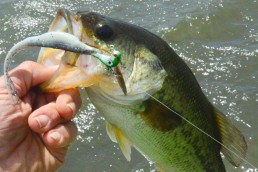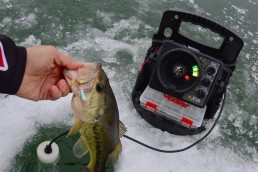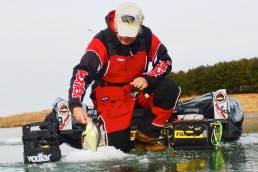Red Fishing Hooks: Red Ice Drift
SHARE THIS POST
Red fishing hooks have grown in popularity the last few years, for open water fishing with soft plastics, or added to lures like jigs, spinnerbaits and crankbaits. They also can be used in ice fishing with a “downward drifting” technique.
The two best-known red hooks are the Daiichi Bleeding Bait and Tru Turn Blood Red Fishing hook series. For ice fishing with a drift technique, I use the Daiichi salmon egg and Tru Turn Aberdeen styles in sizes 6, 8, 10 and 12.
Both hooks are used for fishing wax worms, spikes and Crappie Nibbles. The Tru Turn is used for the baits singly, or in combination, while the smaller shank of the Daiichi salmon egg hook is used for fishing just one of the baits mentioned.
When using the Tru Turn hook in a bait combination, the larger numbers 6 and 8 are normally selected. I like sliding one or two Crappie Nibbles onto the hook shank, and slide them up toward the line-tie eye. Then, a wax worm or spike is hooked once-through, toward the front of the bait. I also like giving it a drop or two of Kick’N Crappie.
The Daiichi hook is covered completely with a Crappie Nibble, or it is used to hook a wax worm or spike in the front or middle. In fact, with spikes, you might want to use more than one.
“Downward drifting” is simply allowing the hook to drift slowly downward without a weight. This is ideal for very finicky biters–especially crappies that feed looking upward, waiting for food to fall to them.
Because of the weightless drift, it helps to use light line. I like using no heavier than 4-pound-test Magna Thin.
Strike detection is extremely important in any fishing, but especially with a downward drift. I use three types of detection: a sensitive rod tip, such as found on Frabill’s Ice Hunter Sniper Quick Tip; an adjustable spring bobber, such as Frabill’s Titanium; and a very small float, or sometimes, simply half a toothpick, with the line tied in the middle.
Are you enjoying this post?
You can be among the first to get the latest info on where to go, what to use and how to use it!
While floats will work, the best detection is a straight line without anything tied to it. This excels when you want to drop the line and lure further than the float allows, or when you let the line coil on the surface, and slowly go down.
My Vexilar FL28 is also a great help in detecting strikes, as it will show if I have fish moving up to take the bait. Just remember not to set the hook on the flash that you see moving in to take your bait; instead, wait for the actual strike that you feel and/or see on the surface when your line moves.
Strikes come in various forms: as a stop in the line falling, if it is a lift bite; a quick jerk; a sideways swimming of the line; or a completely fast pull on a hard strike.
While this is a very productive method of fishing, especially for slow-bite times, it is not good for when your holes are freezing. It can be used anytime inside a heated shelter, but outside in the cold, it will work better in warmer weather. Perhaps this is good, as warmer weather often comes at the end of ice season, which is the time fishing starts getting slower.
Two of the times I’ve found this to work best is when the fish are suspended, or are hitting the bait as it is falling toward the top of a brushpile or weed bed. I have not found it to work as well if the fish are buried in the weeds or brush.
If you are looking for a different technique for ice fishing, try a downward drift with red hooks and bait.
https://midwestoutdoors.com/fishing-new-small-ice/
MWO
SHARE THIS POST
Did you enjoy this post?
You can be among the first to get the latest info on where to go, what to use and how to use it!
Dan Galusha
Dan Galusha has fished all of his life, worked more than 45 years in the outdoor/media industry, and was inducted into the Fresh Water Fishing Hall of Fame as a Legendary Communicator. Direct questions through dansfishntales.com, facebook.com/dansfishntales and facebook.com/shootnplink.



